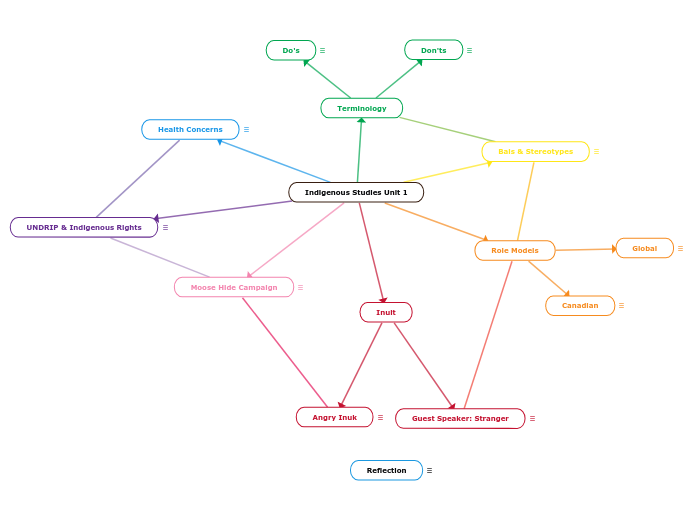Indigenous Studies Unit 1
Terminology
Bais & Stereotypes
Bias: a preference towards a particular perspective which interferes with your ability to be non-judgementalStereotype: an unjustified, usually negative mental picture of a group of peoplePrejudice: a preconceived opinion used to exclude people, a prejudgement without knowing all the factsDiscrimination: unfavourable treatment based on prejudice
UNDRIP & Indigenous Rights
UNDRIP (United Nations Declaration on the Rights of Indigenous Peoples)A document that sets out to define the minimum standards for the rights, dignity, survival and well-being of Indigenous peoplesSome rights included are: all human rights including collective rights, their languages, stories and names, autonomy or self government, improvement of their economic and social conditions, and environmental protection
Moose Hide Campaign
A movement of Indigenous and non-Indigenous men and boys who stand against violence inflicted on Indigenous women and children. It was started by an Indigenous woman and her father to take a stand against violence against womenThey give out Moosehide squares to supporters. Moosehide is used to represent gentleness, comfort, help and love.Fasting: men are invited to fast during the campaign to humble themselves, as a path to healing, and to prove that there is a real commitment to the cause
Health Concerns
Less access to healthcare, they often live in remote areas, may not be covered under national healthcareIndigenous communities are much more likely to have pre-existing conditions, have little access to necessities like clean water and less likely to get quality care from doctorsMore likely to be ignored or misdiagnosed by medical communityLink to other issues: the government often treats Indigenous people as afterthoughts or secondary to colonial populationRecommendations: translation of all covid related messages into Indigenous languages, governments should include Indigenous peoples as recipients of health assistance, governments need to protect Indigenous lands from exploitive outside forces
Role Models
Inuit
Angry Inuk
Imposition of uneducated white/ colonial values on indigenous culture and practicesMisunderstanding of the hunt: Indigenous peoples use all parts of the seal, and the seal hunt sustains their communities and builds capitalIt is a renewable resource, and humanely harvestedIndigenous people have attempted the legal route but have not had much success because animal rights activists have more funding and better marketingAnimal activists have not taken the time to engage with Indigenous people or visit their communties
Guest Speaker: Stranger
Community is the main focus of Indigenous culture: in Inuktitut there is no word for please but over 20 words for thank you. You don't need to ask for things because it will always be given but thanks is always offeredNo one locks doors up North, everThe inuit hunt whales, and do not cook most of their meat, excluding polar bears (dry or smoke)Honour the spirit of loved ones through naming
Do's
be as specific as possible and ask respectfully if you are unsure in naming a person or group
Don'ts
Understand that some language is offensive or derogatoryThese terms are usually labels provided by others, not the name that people give to themselves (aboriginal)
Canadian
Josias Tommy Prince: War hero and one of Canada's most decorated Indigenous soldersNora Bernard: Residential school survivor who filed a lawsuit against the Canadian government that resulted in the largest class action suit in Canada's historyAlethea Arnaquq-Baril: a film maker who makes films about Inuit culture and challenges
Global
Cathy Freeman: Olympic gold medalist for AustraliaAnita Heiss: advocate for Indigenous education and works to publish Indigenous literatureAdam Goodes: A champion Australian footballer
Reflection
My Learning:My involvement with Indigenous communities, previous to this class, had been one that was purely from an activist standpoint, which meant that the main thing I knew about Indigenous people was the challenges that they faced. This gave me a one dimensional picture of Indigenous people. This course has given me insight into how their culture and communities is a place of learning for us. Challenges Indigenous People Face:Health careRacismFood securityIntergenerational traumaWater safetyHousingLack of access to support systemsPurely symbolic reconciliationThe Path Forward:Indigenous representation in governmentFulfilling all of the recommendation the Truth and Reconciliation CommissionEqual funding for basic needsReformation of the foster system
